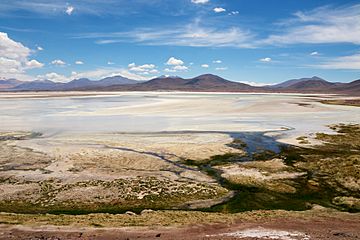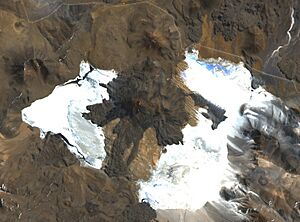Caichinque facts for kids
Quick facts for kids Caichinque |
|
|---|---|

The volcanic complex is in the mid-distance. The snow-patched mountain looming over Caichinque is Pular.
|
|
| Highest point | |
| Elevation | 4,450 m (14,600 ft) |
| Geography | |
| Location | Chile |
| Parent range | Andes |
| Geology | |
| Mountain type | Stratovolcanoes |
Caichinque is a group of volcanoes, also known as a volcanic complex. It is found high up in the Andes mountains, in the Antofagasta Region of Chile. This area is a large, flat plateau.
Caichinque sits between two salt flats, called Salar de Talar and Salar de Capur. It is located southwest of the Salar de Atacama. It is also south of Cerro Miñiques and southeast of Cordón Puntas Negras. Caichinque is part of the main chain of volcanoes in the Andes mountains.
A road called Route CH-23 goes near the volcano. If Caichinque were to erupt, this road could be affected.
What is Caichinque Made Of?
Caichinque is a type of volcano called a stratovolcano. This means it is shaped like a cone and built up by many layers of hardened lava, ash, and rocks.
Volcanic Rocks
The rocks that have erupted from Caichinque are different types. They range from basalt to dacite.
- Basalt is a dark, fine-grained volcanic rock. It forms when lava cools quickly.
- Dacite is a lighter-colored volcanic rock. It has more silica than basalt.
Caichinque also grew on top of an older rock layer. This layer is called a rhyodacitic ignimbrite. An ignimbrite is a rock formed from a very hot, fast-moving flow of gas and volcanic ash.
See also
 In Spanish: Caichinque para niños
In Spanish: Caichinque para niños
- List of volcanoes in Chile
- Cerro Miscanti
- Cerros de Incahuasi


